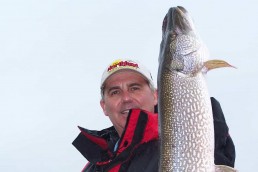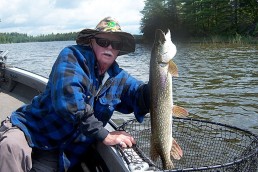Kick off the Season with Vicious Strikes from Feisty Pike
SHARE THIS POST
Considered by many to be the most widespread lethal predatory game fish species in the United States, the pike, also known as the northern pike, is common throughout the colder waterways of the northern states. Its name is derived from the European weapon called a pike, which further confirms its aggressive mannerisms. The pike is also found throughout Canada, and Europe, where the biggest members of its species reside. Pike can become very large if proper habitat and food supplies are present, with documented weights exceeding 40 pounds. These sharks of the freshwater are found in lakes, ponds and rivers.
Pike are adept ambush predators who will remain motionless until prey is seen. Then the pike will either lash out with a tremendous burst of speed to seize the prey or it will sometimes follow the prey for considerable distances, waiting for the prey to falter or show a sign of distress before it attacks. Preys are most other species of fish including other smaller pike. Non-fish species are also eaten, and these include creatures such as juvenile ducks, muskrats, snakes and other small animals that happen to find themselves within the water in the vicinity of a hungry pike.
Preferring colder water around 60 degrees, pike will hold in deeper water during a portion of the fishing season. When weed beds begin to grow in the spring and early summer, pike will move into these areas also as the shade from the weeds provides cooler water temperature and a prime location for the pike to remain in an ambush location. The exception to this is during and just before early spring. In March and April, after the winter ice has melted from the shallow edges of these waters, the pike will move in, seeking the shallow water for the warmth of spawning. Both the males and female pike will populate the shallow water during this time, with the male pike arriving first, sometimes more than a week before the female pike. Often, the pike will hold within water less than five feet deep to take advantage of the warming sun. This habit of holding within shallow water makes the pike a relatively visible target to anglers.
When the pike initially arrive in the shallow water, spawning is the primary purpose that is on their minds. Shallow inlets, bays and coves are prime spawning locations. This spawning season is the only time pike can tolerate being around other pike, as they are normally a solitary species and are quite territorial. When spawning, pike do not show an interest in eating, but will show aggressive tendencies if something gets too close for comfort. After spawning is completed, the male pike will stay close to the egg nesting sights to protect the eggs.
Anglers will find that fishing for pike can be challenging after spawning. The pike are visible lying motionless within the water, but in the initial time period after spawning, pike may not have much of any inclination to respond to a lure. This initial lack of interest soon changes as the lengthening sunlight progressively warms the water. The urge for feeding begins and when the water temperature warms to around 55 degrees, this triggers the primal need to feed heavily.
Post-spawn fishing is all sight-fishing. The angler has a definite sight target and is able to watch the reaction of the pike in response to the lure being cast towards them. Accurate casting is essential. A cast should not be made directly at the pike, nor should it be made behind the pike. The angler must cast off to the front side of the holding pike. Aim for about 20 feet off to the side of the nose of the pike, so that the retrieving lure will go past and about five feet in front of the pike. Repeat the process. Vary the retrieve speeds. If the pike is not in the mood to eat, it will be evident after a couple dozen passes of the lure. When the pike is in a feeding frame of mind, you will not usually even see the pike’s sudden burst of movement to grab the lure. There will be the feel of the hit, or weight on the line as the angler notices a cloud of bottom sediment where the pike was previously stationary.
Are you enjoying this post?
You can be among the first to get the latest info on where to go, what to use and how to use it!
Ultimately, the pike will move out of the spawning locations to move into areas of cover that are in relatively shallow areas, usually less than 10 feet of water depth. Good spots to locate these pike will be within or near the tangled branches of trees that have fallen into the water and pike will also migrate to weed bed areas that may have survived the cold months of winter. When looking down into the water, these early spring holdover weed beds will appear to be green blobs of color under the water. Pike will tuck themselves into these available areas of concealing cover to revert back to their normal ambush tactics for feeding. The urge to feed is often caused by a relatively rapid digestion time period. This is an interesting trait for a fish that will remain nearly motionless after feeding. Most of this feeding will occur during the daylight. There is little, if any activity during the night. Because of this lack of feeding during the night, early morning is a very good time for the angler to be on the water, as the pike will be hungry and are ready to have a meal.
Trolling or casting are both effective early spring fishing techniques. Trolling allows the angler to cover more potential pike holding water more quickly. Casting into or near suspected pike holding areas such as existing weed beds and underwater branches, which puts the angler’s casts directly into known pike territory. Trolling should be done at slow speeds in the early spring, with occasional stopping to let the lure flutter and sink to appear in distress. Casting anglers should also do a slow retrieve at this time of the year, with stopping and jerking the rod tip to impart a wounded prey motion. Both trolling and casting will be done within a few feet from the outside edge of suspected holding areas. Skimming the top of underwater weed beds will also generate strikes from the pike.
The angler must prepare for the sharp teeth of a pike, which will quickly cut the line. A 12-inch section of 20 to 30-pound wire leader can be used at the contact point with the lure. Another technique is to use a 12-inch section of 30- to 50-pound fluorocarbon monofilament. This will have a swivel tied on the end, which is attached to the casting line and a snap swivel tied up the connecting point of the lure. Heavy fluorocarbon is strong and durable, but it still should be inspected regularly for abrasion marks or cuts.
The best lures to use for early spring fishing are spoons, spinners and diving plug baits. Spoons have the fish catching wobble and the attraction of flash to get the attention of a hungry pike. Good colors for spoons are red and white, gold and also silver. Spinners are equally effective as the rotating blade creates both flash and pike attracting vibration. Effective spinner colors are white, yellow and chartreuse. Diving plug baits are now pike producers. Baitfish imitating colors such as silver with a dark back and silver with a blue tint are good choices for the plug baits.
When a pike is caught, the angler fully realizes the viciousness of this aggressive fish. Pike have incredibly sharp teeth and great caution should be used to keep fingers and hands away from their mouths. Forceps or needle nose pliers must be utilized to remove the hook from the mouth of the pike. Pike possess a nasty disposition and will intentionally make an attempt to bite the angler. Be very careful.
Early spring is prime time for a pike angler to get out on the water and catch a big trophy pike. After a long winter, there is nothing like a big bend in the angler’s fishing rod to jump kick the fishing season off to a great start.
MWO
SHARE THIS POST
Did you enjoy this post?
You can be among the first to get the latest info on where to go, what to use and how to use it!
John Murray
John Murray has a passion for the outdoors. A former professional fly tyer and fishing shop owner for more than a decade, John is a member of the NYS Outdoor Writers Association and is determined to share an acquired lifetime of knowledge to help everyone become proficient hunters and anglers.



